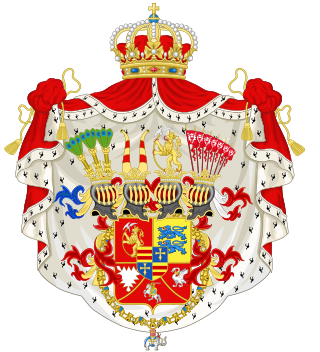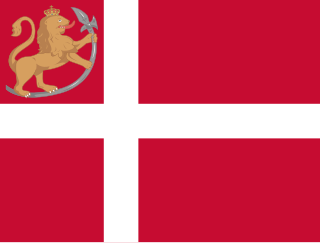
The Kalmar Union was a personal union in Scandinavia, agreed at Kalmar in Sweden as designed by widowed Queen Margaret of Norway and Sweden. From 1397 to 1523, it joined under a single monarch the three kingdoms of Denmark, Sweden, and Norway, together with Norway's overseas colonies.

Christian IX was King of Denmark from 15 November 1863 until his death in 1906. From 1863 to 1864, he was concurrently Duke of Schleswig, Holstein and Lauenburg.

Christian IV was King of Denmark and Norway and Duke of Holstein and Schleswig from 1588 until his death in 1648. His reign of 59 years, 330 days is the longest of any Scandinavian monarch.

Christian VIII was King of Denmark from 1839 to 1848 and, as Christian Frederick, King of Norway in 1814.

Eric, often known as Eric of Pomerania, ruled over the Kalmar Union from 1396 until 1439. He was initially co-ruler with his great-aunt Margaret I until her death in 1412. Eric is known as Eric III as King of Norway (1389–1442), Eric VII as King of Denmark (1396–1439) and has been called Eric XIII as King of Sweden. Eric was ultimately deposed from all three kingdoms of the union, but in 1449 he inherited one of the partitions of the Duchy of Pomerania and ruled it as duke until his death in 1459. Eric of Pomerania was a pejorative intended to point out that he did not belong in Scandinavia.

Christian I was a German noble and Scandinavian monarch under the Kalmar Union. He was king of Denmark (1448–1481), Norway (1450–1481) and Sweden (1457–1464). From 1460 to 1481, he was also duke of Schleswig and count of Holstein. He was the first king of the House of Oldenburg.

Sweden and Norway or Sweden–Norway, officially the United Kingdoms of Sweden and Norway, and known as the United Kingdoms, was a personal union of the separate kingdoms of Sweden and Norway under a common monarch and common foreign policy that lasted from 1814 until its peaceful dissolution in 1905.

The House of Schleswig-Holstein-Sonderburg-Glücksburg, better known as the House of Glücksburg, is a collateral branch of the German House of Oldenburg. Its members have reigned at various times in Denmark, Norway, Sweden, Iceland, Greece, and several northern German states.

Holstein-Gottorp or Schleswig-Holstein-Gottorp is the historiographical name, as well as contemporary shorthand name, for the parts of the duchies of Schleswig and Holstein, also known as Ducal Holstein, that were ruled by the dukes of Schleswig-Holstein-Gottorp, a side branch of the elder Danish line of the German House of Oldenburg. Other parts of the duchies were ruled by the kings of Denmark.

The House of Oldenburg is a German dynasty. Branches of the house rule or have ruled in Denmark, Iceland, Greece, Norway, Russia, Sweden, the United Kingdom, Schleswig, Holstein, and Oldenburg. The current kings of Norway and the United Kingdom are patrilineal descendants of the Glücksburg branch of this house.

In 1814, the Kingdom of Norway made a brief and ultimately unsuccessful attempt to regain its independence. While Norway had always legally been a separate kingdom, since the 16th century it had shared a monarch with Denmark; Norway was a subordinate partner in the combined state, whose government was based in Copenhagen. Due to its alliance with France during the Napoleonic Wars, Denmark was forced to sign the Treaty of Kiel in January 1814 ceding Norway to Sweden.
The Kingdom of Norway as a unified realm dates to the reign of King Harald I Fairhair in the 9th century. His efforts in unifying the petty kingdoms of Norway resulted in the first known Norwegian central government. The country, however, soon fragmented and was collected into one entity in the first half of the 11th century, and Norway has retained a monarchy since that time. Traditionally, it has been viewed as being ruled by the Fairhair dynasty, though modern scholars question whether the eleventh century kings and their successors were truly descendants of Harald.
Riksrådet or Rigsrådet is the name of the councils of the Scandinavian countries that ruled the countries together with the kings from late Middle Ages to the 17th century. Norway had a Council of the Realm that was de facto abolished by the Danish-Norwegian king in 1536–1537. In Sweden the parallel Council gradually came under the influence of the king during the 17th century.

Olav Nilsson Skanke was a Norwegian nobleman, knight and privateer. He was a member of the Riksråd and served as commander of Bergenhus Fortress.

Visborg (Wisborg) refers to a fortress in the town of Visby on the Swedish island of Gotland. Successive fortresses were built in Visby, though Visborg is usually in reference to the castle built here by King Eric of Denmark, Norway, and Sweden.

The monarchy of Denmark is a constitutional institution and a historic office of the Kingdom of Denmark. The Kingdom includes Denmark proper and the autonomous territories of the Faroe Islands and Greenland. The Kingdom of Denmark was already consolidated in the 8th century, whose rulers are consistently referred to in Frankish sources as "kings". Under the rule of King Gudfred in 804 the Kingdom may have included all the major provinces of medieval Denmark.

Denmark–Norway was an early modern multi-national and multi-lingual real union consisting of the Kingdom of Denmark, the Kingdom of Norway, the Duchy of Schleswig, and the Duchy of Holstein. The state also claimed sovereignty over three historical peoples: Frisians, Gutes and Wends. Denmark–Norway had several colonies, namely the Danish Gold Coast, the Nicobar Islands, Serampore, Tharangambadi, and the Danish West Indies. The union was also known as the Dano-Norwegian Realm, Twin Realms (Tvillingerigerne) or the Oldenburg Monarchy (Oldenburg-monarkiet).
Events in the year 1450 in Norway.
The Treaty of Tsarskoye Selo was a territorial and dynastic treaty between the Russian Empire and Denmark–Norway. Signed on 1 June 1773, it transferred control of ducal Schleswig-Holstein to the Danish crown in return for Russian control of the County of Oldenburg and adjacent lands within the Holy Roman Empire. The treaty reduced the fragmentation of Danish territory and led to an alliance between Denmark–Norway and Russia that lasted into the Napoleonic Wars. It also made possible the construction of the Eider Canal, parts of which were later incorporated into the Kiel Canal.















